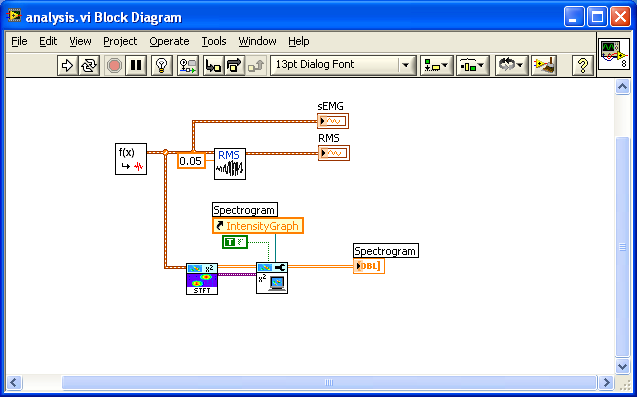From Friday, April 19th (11:00 PM CDT) through Saturday, April 20th (2:00 PM CDT), 2024, ni.com will undergo system upgrades that may result in temporary service interruption.
We appreciate your patience as we improve our online experience.
From Friday, April 19th (11:00 PM CDT) through Saturday, April 20th (2:00 PM CDT), 2024, ni.com will undergo system upgrades that may result in temporary service interruption.
We appreciate your patience as we improve our online experience.
02-10-2010 05:39 AM
hi,
i m doin my project on EMG analysis.. if someone having the EMG simulator VI then please provide as we are not acquiring the signal from real world.
thanks
Amit
02-10-2010 06:19 AM
At least on this site
http://www.emglab.net/emglab/index.php you will find some signals you can download
02-10-2010 07:40 AM
Please see the attached file for simulation of surface electromyogram signals. This VI simulates isotonic contractions by mathematical modeling. It is possible to change the code for simulaion of isometric contractions as well. Please let me know some more about your application.
Regards,
Arthur de Sá Ferreira
PhD² Consultoria e Sistemas - http://www.phd2.com.br
http://lattes.cnpq.br/5432142731317894
02-10-2010 09:05 PM
Thanks!
BTW, you could use NI Biomedical Startup Kit Source Code 2.1.1 to do some basic EMG analysis. I just use the simulated EMG:


02-10-2010 09:14 PM
Hi Ferreira,
Thanks for the attachment. I have a question about your codes. It seems that the simulated sEMG's power distribution (regardless of amplitude) is not changing over time. I mean that the mean power frequency of the simulated sEMG is not changing a lot. In my mind, it is not the case. When in muscle contraction, the mean power frequency should be larger.
What do you think?
ZJ Gu
02-11-2010 12:51 PM
Hi Gu,
You did a good job with the code for simulation of sEMG signals. During sustained contractions (fatigue), the median frequency (MDF) decreases while the root mean squere (RMS) increases. This code does not simulate fatigue conditions so you won't see significant changes in MDF for each sEMG burst.
To simulate fatigue-like contractions you need another simulation model which accounts for spectral changes over time. A good model was provided by Shwedyk, Balasubramanian & Scott (1977) IEEE Trans Biom Eng 24: 417-424. This equation models the power spectrum of sEMG signals. In equation, fL and fH stands for the low and high frequencies of the sEMG signal being simulated. I suggest you to simulate a time-varying bandwidth to create progressive spectral changes and convert them into time domain signals. This should generate the EMG signal with sMDF changes.
Please let me know your results.
Regards,
Arthur Sá Ferreira
PhD² Consultoria e Sistemas - http://www.phd2.com.br
http://lattes.cnpq.br/5432142731317894
02-11-2010 07:49 PM
Hi Ferreira,
Thank you for the information.
I am considering to add the EMG Simulation function in Biomedical Startup Kit next update. I want to know how many users want the feature? ![]()
ZJ Gu
02-12-2010 11:46 AM
I WANT IT!
THANKS!
02-12-2010 02:37 PM
Hi Ferreira,
Thanks for the useful VI
regards
amit
02-12-2010 02:38 PM
i need it